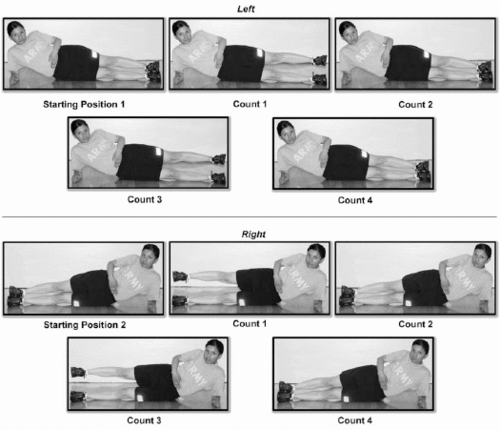The lateral leg raise, often referred to as the ‘side-lying leg lift’ or ‘side leg lift,’ stands out as a potent exercise to activate various muscle groups simultaneously.
- Especially recommended for those with sedentary lifestyles, like desk jobs, it’s a stellar way to counteract prolonged sitting and strengthen specific muscle groups.
Army PRT Lateral Leg Raises
The lateral leg raise is the first hip stability drill exercise. This exercise strengthens the lateral hip and upper leg muscles.
Lateral leg raises help to develop strength and stability in the hip muscles, improving foundational readiness for more rigorous training and combat tasks involving:
- Foot marching
- Running
- Jumping
- Squatting
- Bounding

Starting Positions
Position 1: Right Side
- Lay on the right side with the legs extended straight to the side and the feet together with the toes pointing straight ahead.
- Support the upper body with the right elbow. The elbow is bent at 90 degrees, the upper arm is perpendicular to the ground, and the right-hand makes a fist vertical to the ground.
Position 2: Left Side
- Lay on the left side with the legs extended straight to the side and the feet together with the toes pointing straight ahead.
- Support the upper body with the left elbow. The elbow is bent at 90 degrees, the upper arm is perpendicular to the ground, and the left-hand makes a fist vertical to the ground.
Cadence:
- SLOW
Count
- On the count of one, raise the top leg so the top foot is 6 to 8 inches above the ground.
- On count two, return to the starting position.
- On count three, raise the top leg so the top foot is 6 to 8 inches above the ground.
- On count four, return to the starting position.
Repeat 5 to 10 times, then switch to the other side.
Command
- On the command, “change position move,” swing the legs toward the front of the formation, swiveling on the buttocks into the second starting position, the left side-lying position, with the trunk supported on the left elbow.
- Complete the same series of repetitions for the right leg and hip.
- Return to the starting position and then to the position of attention.
Check Points
- Face the front of the formation, maintaining a straight line with the body.
- On counts 1 and 3, keep the knee of the raised leg straight and the foot pointing forward. The top leg raises no more than 6–8 inches above the ground.
- Place the top hand over the stomach throughout the exercise.
Muscles Worked by Lateral Leg Raise
The lateral leg raise works on the following muscles:
- Hip abductors
- Gluteus minimus and medius
- Hamstrings
- Core muscles
- Lower back muscles
- Tensor fascia lata (TFL, a knee flexor muscle)
How to Do the Lateral Leg Raise at Home
- Lie on your left side, ensuring your body aligns straight with your legs stacked.
- Support your head with your left hand and stabilize the lower body using your right hand on the left hip or leg.
- Exhale and raise your right leg skywards.
- Elevate the leg as high as comfortable, avoiding strain.
- Inhale as you return to the starting position.
- Aim for 10-15 reps on each side.
Safety Considerations
- Daily Execution: You can do lateral leg raises daily as they are gentle on muscles. They’re even recommended in physical therapy routines post-injuries.
- Weighted Variations: Using weights necessitates caution. Weighted lateral leg raises can strain muscles if done daily. Hence, taking breaks between sessions is advised to allow muscle recovery.
- Listen to Your Body: If discomfort or pain arises, halt the exercise. Ensuring that your form is correct is paramount to avoid any potential injuries.
Outcome Predictions
- Two Weeks: Expect a stronger, toned lower body after a fortnight. Enhancements in balance, coordination, and posture will also be noticeable.
- Thirty Days: A month of commitment will amplify the two-week results, potentially diminishing love handles and boosting overall body control, stamina, and endurance.
Dos and Don’ts
- Weight Impacts: While weighted leg raises boost hip and thigh muscle strength, they don’t cause a substantial size increase.
- Slimming Thighs: Complement this exercise with cardiovascular activities like running or cycling for optimal slimming results.
- Dietary Impact: Consuming a balanced diet will synergize with your exercise regimen for the best outcomes.
Benefits of Lateral Leg Raises
The lateral leg raise exercise has a variety of benefits, as follows:
- Toning and Strengthening: This exercise targets muscles like the quads, glutes, hamstrings, and outer thighs, ensuring they become more defined and stronger.
- Core Activation: Lateral leg raises engage core muscles such as the transverse abdominals and obliques, promoting a robust core.
- Flexibility: This exercise opens up hip muscles, enhancing your range of motion and hip flexibility.
- Balance and Coordination: This exercise can drastically improve your body’s stabilization, benefiting daily activities ranging from hiking to skating.
- ACFT Test: Lateral leg raises keep soldiers fit and help them pass the standards for the Army ACFT Score Chart 2024.
Frequency Recommendations
The maximum number of reps you should do depends on your fitness level. For beginners or those recovering from injuries:
- Start with three sets of 10 repetitions.
- Gradual increment to 15-20 reps per set.
- Upper limit: Around 100–150 reps daily if unweighted.
- Essential: Incorporate rest days between strenuous sessions to prevent overexertion.
Whether you are a seasoned athlete or a beginner, the lateral leg raise can be a valuable addition to your fitness regimen, promoting strength, balance, and overall mobility.
- Empowering Transactions: Navigating Firearms Sales with Proper Documentation - April 8, 2024
- Army PRT – Preparation and Recovery 2024 - March 18, 2024
- Active and Reserve Components 2024 - March 6, 2024
